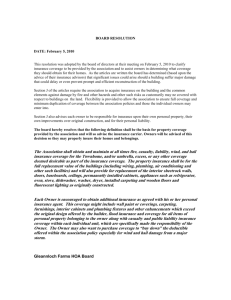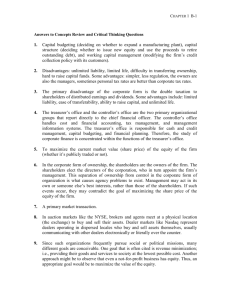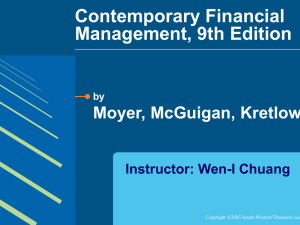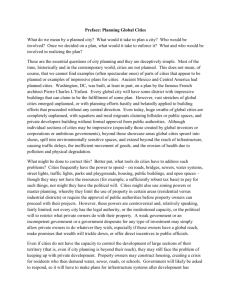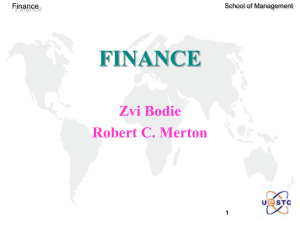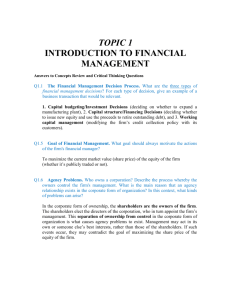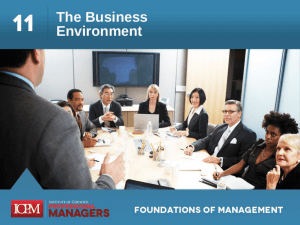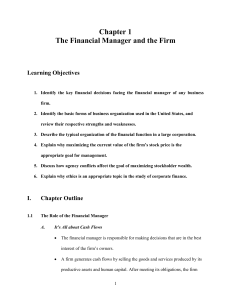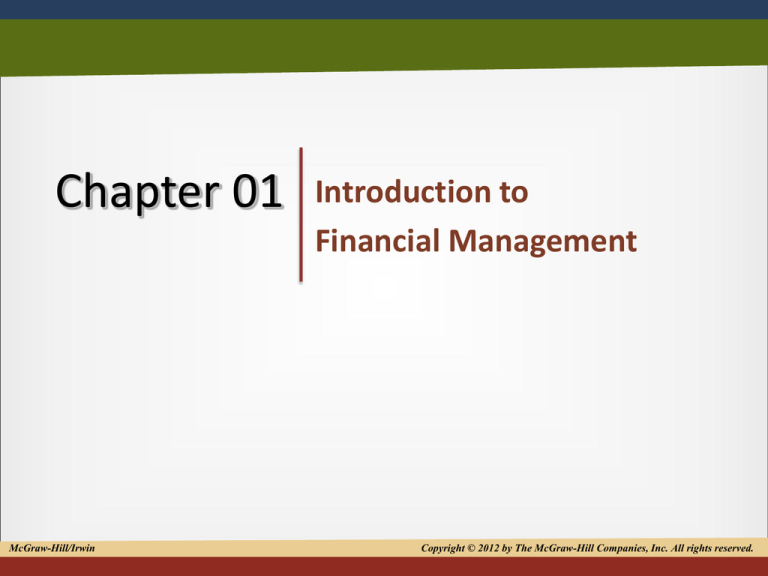
Chapter 01
McGraw-Hill/Irwin
Introduction to
Financial Management
Copyright © 2012 by The McGraw-Hill Companies, Inc. All rights reserved.
1
What is Finance?
• Finance applies specific value to
– things owned
– services used
– decisions made
• Financial management
– organization’s approach to valuation
1-2
Economic Participants
• Two dimensions
– Participants with “extra” investment money
– Participants with economically viable ideas
1-3
Economic Participants
• Type 1 Participants
– Do not lend or spend in business context
– No direct role in financial markets
– Indirect role: to provide labor and consume products
1-4
Economic Participants
• Type 4 Participants
– Use financial tools
• evaluate own businesses
• choose highest-potential ideas
– Are self-funded, so no need for financial markets
1-5
Economic Participants
• Types 2 and 3 Participants
– use financial institutions and financial markets for
mutually beneficial exchange
• Type 2: makes temporary loans to Type 3
• Type 3: typically consists of companies engaging in
R&D
1-6
Where Does the Cash Go?
• Economically successful projects repay money
(plus profit) to investors
• Friction occurs when not all cash is returned
to investors
- Retained Earnings
- Taxes
1-7
Figure 1.4
Complete Cash Flows of Finance
1-8
Subareas of Finance
• Investments
– involves methods and techniques for making
decisions about what kinds of securities to own
1-9
Subareas of Finance
• Financial management
– Decisions about acquiring and using cash
– Examples include
• Organizing and raising capital
• Tax decisions
• Projects to fund
1-10
Subareas of Finance
• Financial institutions and markets
– Facilitate flow of capital between investors and companies
• International finance
– Finance theory used in global business environment
1-11
Financial Decision
Application & Theory
• Risk
– Uncertainty of future cash flows due to timing and
size
• Financial Asset
– Ownership in cash flow represented by securities
like stocks, bonds, and other assets
1-12
Financial Decision
Application & Theory
• Real Assets
– Physical property like gold, machinery, equipment,
real estate
• Real Markets
– Places/processes that facilitate real asset trading
• Time Value of Money (TVM)
– Theory and application of valuing cash flows at
various points in time
1-13
Finance vs. Accounting
• Accounting
– tracks what happened to firm’s money in the past
• Financial Management
– combines historical figures and current
information
– determines what should happen with firm’s
money now and in the future
1-14
The Financial Manager
• Chief Financial Officer
CFO
– Highest level financial officer
• Controller
Treasurer
Controller
– Oversees accounting function
• Treasurer
– Responsible for managing cash, credit, financing, capital
budgeting, risk management
1-15
Finance in Other Business Functions
• CFO and Treasurer
– most visible finance-related positions
• Finance permeates the organization
• Used to develop and manage strategy
• Used in day-to-day business operations
– Operations
– Marketing
– Human Resources
1-16
Finance in Your Personal Life
• Help you make good personal financial
decisions
– Borrowing money for a new car
– Refinancing home mortgage at lower rate
– Making credit card or student loan payments
– Saving for retirement
1-17
Business Organization
• Single owners, partners, and corporations
operate businesses
• Advantages and disadvantages related to
• Controls and ownership of firm
• Owners’ risks
• Access to capital and tax ramifications
1-18
Business Form Types
• Sole Proprietorships
• General Partnerships
• Corporations
• Hybrids
1-19
Sole Proprietorships
• Not legally separate from the owner
– Advantages
• Easy to start
• Light regulatory and paperwork burden
• Single taxation at the personal tax rate
– Disadvantages
• Unlimited liability
• Limited access to capital
1-20
General Partnerships
• Partners own the business together
– Advantages
• Relatively easy to start
• Single taxation
– Disadvantages
• Partners jointly share unlimited liability
• Personally liable for legal actions and debts of firm
• Difficult to raise large amounts of capital
1-21
Public Corporations
• Legally independent entity entirely separate
from its owners
– Advantages
• Limited liability for owners
• Can raise large amounts of capital
• Easy to transfer ownership
– Disadvantages
• Double taxation (corporate level and personal level)
1-22
Hybrid Organizations
• Combine attributes of several forms
– Advantages
• Offer single taxation and limited liability to all
owners
– S Corporations
– Limited Liability Partnerships (LLPs)
– Limited Liability Companies (LLCs)
1-23
Firm Goals
• Owner seeks to maximize shareholder wealth
and company’s value through
– Maximizing present value of future cash flows
– Maximizing owners’ equity
– Decisions about
• attracting additional funds
• projects in which to invest
• returning profits to owners over time
1-24
Corporate Goals
• Maximize value of owners’ equity
– Increase current value per share (stock price) of
existing shares
• Common methods
– Maximize net income or profit
– Minimize costs
– Maximize market share
1-25
Agency Theory
• Problems arise when principal (shareholder)
hires agent (manager) to operate firm but
cannot monitor the agent’s actions
• Manager’s interest may not be aligned with
shareholder goals
1-26
Agency Theory
• Three approaches to minimizing this conflict of
interest
– Ignore if effect is minimal
– Use accountants, debt holders to monitor managers
– Provide incentives to managers
• Equity stakes
• Stock options
• Employee Stock Option Plan (ESOP)
1-27
Corporate Governance
• Set of laws, policies, incentives, and monitors
designed to handle issues arising from the
separation of ownership and control
1-28
Corporate Governance
• Inside monitors
– Board of Directors
• Hires the CEO
• Evaluates management
• Designs compensation plans
1-29
Corporate Governance
• Outside monitors
•
•
•
•
Auditors
Analysts
Banks
Credit rating agencies
1-30
Corporate Governance Monitors
1-31
Ethics
• Financial professionals manage other people’s
money
– Corporate managers
– Bankers
– Investment advisors
• Ethical dilemmas of corporate agency relationship
– Stealing from firms = stealing from shareholders
1-32
Financial Markets and Intermediaries
• Financial markets and financial intermediaries
– Facilitate flow of capital from investors to firms
and back to investors
– Earn very high profits because of specialized
expertise and assets
1-33
Financial Institution Cash Flows
1-34
The Financial Crisis
• Subprime Mortgage Borrowers
– Higher-risk borrowers charged higher interest
rates due to higher risk of default
• Securitization
– Loan originators sell the loan repayment rights to
other financial institutions or investors
1-35
The Financial Crisis
• Sparked by collapse of U.S. home prices in late
2006 and 2007
• Spread to other financial institutions via
affected mortgage-backed securities
• Resulted in credit tightening by financial
institutions; loss of confidence by consumers
1-36

